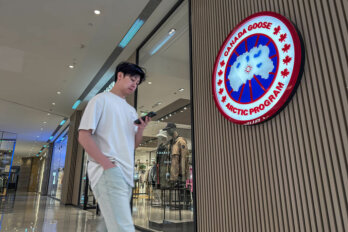On March 31, around the time North America began imposing widespread lockdown measures, a new Instagram account debuted, documenting people’s work-from-home outfits. The account, called Quarantine_SS20—a reference to the spring/summer 2020 fashion season—was quickly flooded with submissions: people sharing photos of their isolation looks alongside brief explanations of the choices behind them. Some outfits are wildly inventive, like that of womenswear designer Dorottya, who is featured in avant-garde masks that look like a cross between a bonnet and a torture device from the Saw franchise. Others incorporate beloved pieces usually reserved for special occasions—like Matthew, a cabinetmaker in Brooklyn wearing his father’s wedding suit.
Started by Doris Domoszlai-Lantner, a fashion historian and archivist in New York, and Zsófia Kormos, a fashion researcher in Budapest, Quarantine_SS20 has received more than 150 submissions from twenty-five countries. As with Working From Home Fits, a similar account featuring fashion insiders’ eclectic at-home looks, Quarantine_SS20 highlights clothing’s affirmative power to build identity, express individuality, and cultivate community even during a crisis. “Maybe you’re just hanging out in your underwear,” says Domoszlai-Lantner in a video interview, acknowledging the much-discussed rise in loungewear. “[But] I think a lot of people are going to look for the opposite . . . for crazy patterns or outlandish silhouettes or pieces that maybe they wouldn’t have bought before.” Scrolling through the account is a powerful reminder that an outfit, no matter how experimental or nondescript, is the culmination of many choices that we make to reflect who we are—or who we’d like to be.
But the norms around style and fashion are, like much of the world, in a state of upheaval. As the pandemic tightens its grip on the economy, Canada’s unemployment has reached a record high, decimating sectors from media to energy. Fashion is not immune: the $3.35 trillion industry will suffer an estimated 27 to 30 percent drop in global sales this year, according to a report by Business of Fashion and McKinsey, leaving both retail stalwarts and independent brands shuttered or bankrupt. The latest available data shows a 69 percent drop in Canadian sales for clothing and accessories stores compared to last year, as reported by retail-and-marketing consulting firm J. C. Williams Group. The United States also shows declining numbers. In one podcast, luxury expert and analyst Luca Solca warned that sluggish sales and a disrupted supply chain would make the first half of this year “the worst . . . in the history of the luxury industry.”
As an industry that relies on a cycle of endless consumerism, fashion now faces an existential crisis. Clothes will eventually repopulate racks, but who will buy them and where they’ll wear them are lingering questions. The virus has suspended public life, largely halted consumption and, at least theoretically, eliminated the ritual of getting dressed. Wearing anything other than sweatpants or pyjamas seems illogical; a virtual conference requires, at best, a presentable waist-up outfit. But projects like Quarantine_SS20 serve as a cultural bellwether, offering a glimpse into how the crisis will inform the future of fashion—even with nowhere to go and no one to see.
So much of fashion’s power is relational: we dress to be seen and ask that others validate the person we’re projecting. But, with only ourselves as judges, we’re starting to dress differently—more faithfully, perhaps, to who we actually are and who we might become.
Historically, global crises have ushered in new styles. Alison Matthews David, a historian specializing in the intersection of fashion and medical history, has found that these trends were often influenced by how people imagined diseases to be transmitted. During the Renaissance, for example, people wore perfumed gloves and accessories to protect them from the bad smells that were thought to spread disease; the Manchurian plague, in 1910/11, led to the mass adoption of masks. “In a way, we were always sort of dressed for the danger of disease,” Matthews David says. She predicts that the dismal economic forecast means we’ll be looking for ways to innovate our wardrobes beyond buying: “I feel like we’re in this moment where you might see Depression era or World War II [ideas of] ‘make do and mend,’ or maybe tie-dye stuff or play with what you already have.” Parts of her projection are already coming true: Google searches for tie-dye have been steadily trending upward around the world since March.
Those who can still afford to shop are increasingly hunting for ways to pandemic-proof their wardrobes. This has translated into a desire for protective gear on the part of both makers and consumers. Andrea Bell, director of insight at trend-forecasting firm WGSN, has a more clinical term for the movement: post-traumatic stress design. “Short term, the fashion industry is pivoting to ‘How do I make sure that the person feels comfort, protected, and safe?’” she says.
But, even while we remain mostly indoors, our styles of dress are already changing. Social isolation has presented new opportunities for creative expression and even subversion. We’re already seeing glimmers of more gender-fluid dressing. Actor Armie Hammer posted an Instagram photo during quarantine in which he wore a fringed crop top, a notable departure from conventionally masculine style. In June, London’s digital fashion week went gender neutral, combining the men’s and women’s shows under the same banner for the first time in its thirty-six-year existence. “I hope gender boundaries [become] more fluid . . . rather than this regression into like, ‘Okay, let’s go back to our Bay Street suits,’” says Matthews David of the eventual return to the office. Even quarantine hair trends across genders—shaving, growing, dyeing—have sparked a newfound joy in playing with identity.
While some relish the sartorial freedom afforded in quarantine, those whose identities hinge on their careers may feel unmoored without an office dress code. “The physical act of getting dressed can help us [feel in control],” says Carolyn Mair, a behavioural psychologist and the author of The Psychology of Fashion. “It helps us establish and maintain our self-identity with work, which contributes to our self-worth.” As many people shift toward working from home long-term, we can see this need for structure creeping into things like Zoom calls. Andrea Bell has noticed an uptick in internet searches for necklaces, earrings, and scarves across all genders, reflecting a renewed attention to necklines—one of the most visible parts of one’s outfit during a video call. “There’s still so much that’s out of our control with the virus and the conditions we all live under,” she says. “So we take control of what we can control, and one way we do that is through what we wear.”
Over the past decade, social media has usurped the power to dictate trends from fashion’s gatekeepers and transferred it to consumers. Advertisers’ shrinking budgets are thinning the pages of fashion’s remaining glossies while fashion reporters at the New York Times question the purpose and relevance of these magazines amid a public health crisis. Platforms such as Instagram and Styleforum, along with e-commerce sites like Ssense and Grailed, have all but replaced magazines as shoppers’ primary sources of fashion inspiration, discovery, and community. Relatability and authenticity, then, seem to be today’s strongest cultural currencies—and the brands capitalizing on them could have a stronger hand in shaping fashion’s future.
Brands that utilize social media to communicate directly with their consumers during quarantine are well positioned for postpandemic success, explains retail consultant Lisa Hutcheson, citing Lululemon as a notable example. Despite a dip in quarterly sales, Lululemon’s stock rose 74 percent from mid-March. She says the yoga brand’s swift response to the crisis on social media—from announcing an economic relief package for brand ambassadors to offering discounts to health care workers—has resonated with shoppers. The athleisure behemoth is also adapting to the new popularity of home fitness: in March, during the first week of global lockdowns, more than 170,000 users tuned in to the live yoga classes taught by brand ambassadors on Instagram.
Another brand that’s faring well is Entireworld, a direct-to-consumer line of colour-saturated sportswear based in Los Angeles. Popular among the influencer set, the label is seeing a massive surge in sales for its primary-coloured sweatsuits during quarantine, mostly among women. Founder Scott Sternberg credits the product’s popularity to its vibrant palette—psychological studies have shown that colour can affect our mood, perception, and productivity. After Sternberg encouraged his staff to “pick a colour [of sweatsuit] and wear it around for the day,” he and his employees felt curiously uplifted. Sternberg also thinks the long-term shift to remote work will be the catalyst for a permanently relaxed wardrobe—but one that doesn’t sacrifice uniqueness.
Athleisure, sportswear’s hipper cousin, is also poised for postpandemic success. Independent brands are reaping the benefits of the sudden spike in at-home clothes: the Globe and Mail reported that online sales doubled at Free Label, a line of sustainable basics based in Vancouver. High-end consumers are prioritizing stylish comfort over directional fashion too. At Holt Renfrew, Balenciaga and Givenchy hoodies have been selling well online, according to women’s fashion director Joseph Tang. But, without physically seeing new collections, buyers have “had to be more innovative with how to signal newness and trends to customers.” While the luxury mecca is pivoting away from evening wear for the fall season, Tang insists that ready-to-wear fashion will remain relevant once restrictions on group gatherings ease. But, with weddings postponed and gatherings limited, sensible, functional, and timeless clothing may feel more appropriate than party frocks and couture.
Fashion can feel like an especially frivolous or even vulgar pursuit in the face of disease, poverty, and injustice. We’re living through a moment in which people are rethinking their moral relationship to shopping on both the consumer and producer sides. A 2,000-strong group of independent designers, CEOs, and retailers, have proposed an overhaul of fashion’s untenable system, the aim being to produce less, reduce waste, and eliminate discounts. Recent uprisings against police brutality have laid bare the institutionalized racism that permeates all spheres of life, including the fashion industry. New initiatives, like Aurora James’s 15 Percent Pledge, are calling on big business, including Canadian retailers Ssense, Hudson’s Bay, and Holt Renfrew, to support brands that are owned by Black, Indigenous, and other racialized designers in a way that reflects the country’s demographics.
Investing in Black brands, which have historically been disregarded by the fashion establishment, is one way to tangibly contribute to racial and economic justice. And, without generalizing, Black designers, including Kerby Jean-Raymond, Spencer Badu, Martine Rose, and Grace Wales Bonner, express perspectives that are often rooted in Black culture and reflect a multivalent view of the Black experience. They also challenge the stubborn ideals of beauty, style, and gender that have historically championed whiteness. As we grapple with where our dollars go—and whom they go to—buying Black could also change the way we dress. “For me, it’s really about corrupting the history that’s entrenched in these pieces,” says Badu of reinterpreting the modern-day uniform for a new generation of socially conscious shoppers. “At times, it’s good to pose questions to the world or to your consumer.”
The crisis has upended our social and economic systems, leaving fashion in a state of flux. People are scaling back their luxury purchases and even questioning whether they should be shopping at all. In a world shaped by social isolation and financial uncertainty, many of us are making do with what we have. But these conditions have also offered a rare opportunity for unfettered creative expression: without the social diktats of dress codes, personal style and individuality can finally flourish.
If conspicuous consumption also falls out of vogue, fashion will be about not who you’re wearing but how you’re wearing it. And, when you dress for yourself, who’s to say what’s daring, acceptable, or appropriate? We may be left with only the clothes on our backs, but we will wear them however we see fit.




